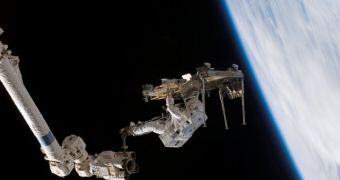On Earth we are protected from radiation by the planet's magnetic field and its thick atmosphere, however astronauts in Earth's orbit are not so lucky, and may receive doses of radiation while in space higher than if they were supposed to remain on the surface of the planet. Though not lethal on short periods of time, radiation poisoning could have serious consequences over long periods of time.
ESA researchers are currently developing a method to predict the radiation doses received by astronauts while on-board the newly installed European module Columbus, with the help of computer models that take into consideration variables, such as the amount of radiation outside the space station, the radiation retained by the protective layers of the station, and the exact amount of radiation that escapes the protection layers to enter human body, information essential for future missions to the Moon and the planets in the solar system.
The study was initiated by Christer Fuglesang, ESA astronaut and part of the crew on-board the ISS during December 2006, who provided a clear example of radiation interaction with the human body. During his stay on the ISS, he experienced what is known as radiation ionization, which could be directly observed, while closing your eyes, through the appearance of bursts of flashes. What happens is that elementary particles interact with the human eye and determine the emission of photon particles of light.
As you probably imagine, the frequency of the flashes is in direct relation with the amount of radiation, thus with the solar activity. To partially avoid the exposure, during sleep time astronauts sleep in the most shielded areas of the space station. With the help of the Dose Estimation by Simulation of the International Space Station Radiation Environment, ESA will be able to predict the radiation doses on-board Columbus, by simulating radiation passing through the wall on the space station and into the human body. The data provided by the computer simulations has been previously used into space physics and medical physics by international collaborations, such as the one involving ESA and CERN.
The most difficult aspect of the whole problem lies in constructing a computer model of the whole space station starting from scratch. ESA's Columbus module represents Europe's contribution to the build of the ISS, and is currently the most complex laboratory launched in space by Europe. Amongst its numerous experiments, lies the DESIRE radiation monitor that will provide with results to be compared with actual measurements.
During quiet solar activity times, Columbus should provide enough shielding against radiation, although the radiation levels would still be at least seven times higher than those on the surface of the Earth. Beyond Earth's orbit, however, is another situation, as spacecrafts would no longer be in the protective care of Earth's magnetic field and will have to be capable of absorbing most of the Galactic Cosmic Rays and energetic particles present in the solar wind.
ESA engineers, as those from NASA, argue that the Apollo missions conducted to the Moon, from 1960 to 1970, were just lucky not to be hit by a massive solar storm, which could inflict long term damage on the bodies of the astronauts participating in those missions. Future manned missions through the solar system will have to make use of more robust radiation prediction systems, in order to maintain the radiation levels at a safe limit.
Also, the ESA can make predictions of the radiation in the surrounding environment with its fleet of spacecrafts traveling through the solar system, such as Integral and Rosetta, equipped with Standard Radiation Environment Monitors developed by Oerlikon Space and Paul Scherrer Institute. Only after that can the ESA imply a strategy to counter the radiation hazards posed by space.

 14 DAY TRIAL //
14 DAY TRIAL //